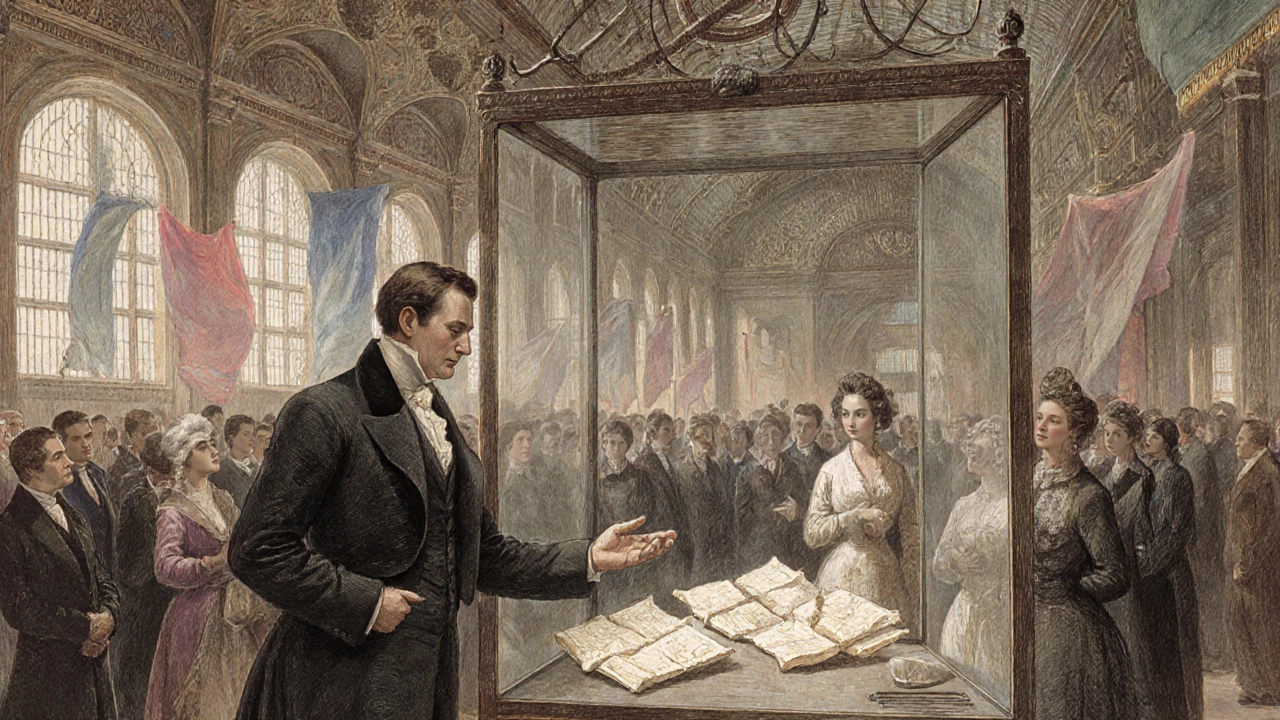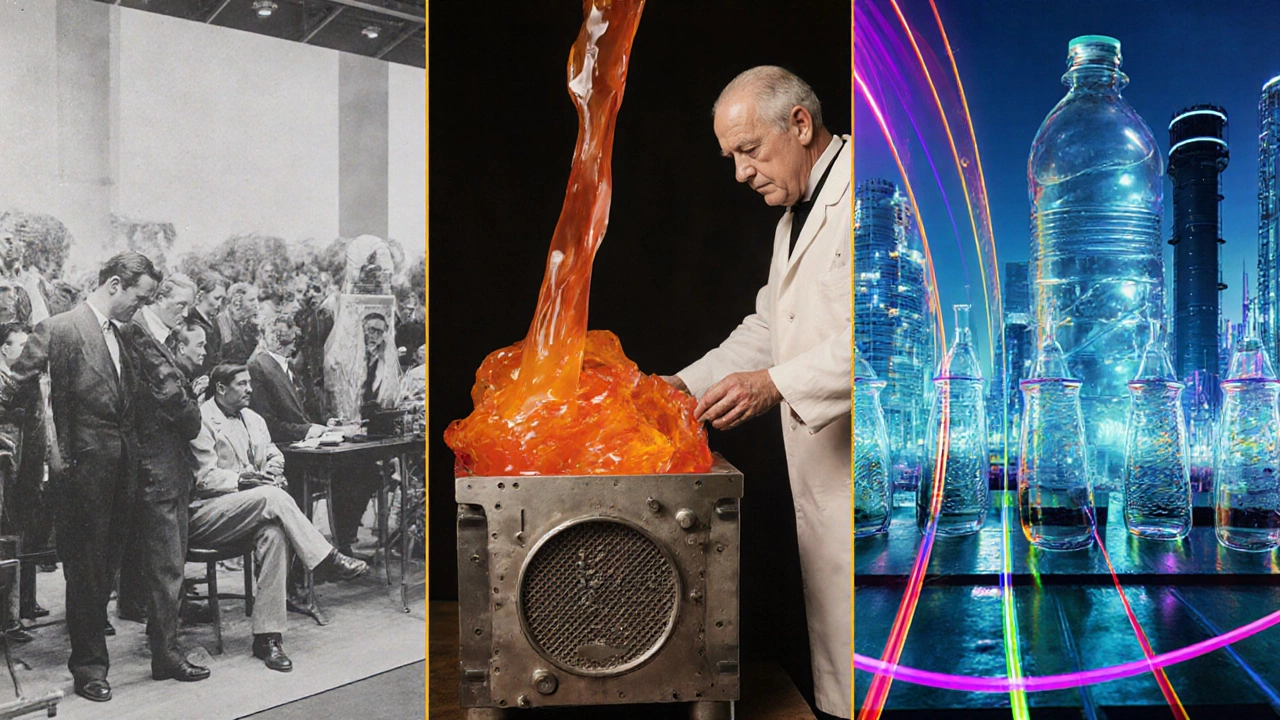
Plastic Materials Comparison Tool
Compare key attributes of historical plastic materials by selecting the plastics you want to view side-by-side.
Comparison Results
| Attribute | Parkesine | Celluloid | Bakelite | PVC | PET |
|---|---|---|---|---|---|
| Inventor | Alexander Parkes | John Wesley Hyatt | Leo Baekeland | Hermann Staudinger | John Rex Whinfield & James Tennant Dickson |
| Year | 1862 | 1869 | 1907 | 1926 | 1941 |
| Main Uses | Decorative items, experimental molds | Film, billiard balls, combs | Electrical insulators, radios | Pipes, cables, window frames | Bottles, food trays |
| Key Property | Brittle, thermoplastic | Flexible, flammable | Thermoset, heat-resistant | Durable, chemical-resistant | Clear, strong, recyclable |
Key Takeaways
- Alexander Parkes created the first semi‑synthetic polymer, Parkesine, in 1862.
- John Wesley Hyatt commercialized celluloid in 1869, making the first true plastic mass‑produced.
- Leo Baekeland invented Bakelite in 1907, the first fully synthetic plastic that sparked the modern plastics industry.
- Subsequent synthetics like PVC (1926) and PET (1941) expanded plastic applications dramatically.
- Understanding these milestones helps manufacturers trace material choices back to their origins.
When you pick up a water bottle, a phone case, or a kitchen gadget, you probably never wonder who invented plastic. Yet the story of plastic is a chain of breakthroughs that reshaped every manufacturing sector, from automotive to food processing. Below we walk through the key inventors, the materials they created, and how each breakthrough paved the way for today’s multi‑billion‑dollar industry.
Plastic is a synthetic or semi‑synthetic polymer that can be molded when heated and retains its shape when cooled. Its versatility stems from a handful of early inventions that turned natural resins and cellulose into mass‑produced materials.
1. The First Semi‑Synthetic Attempt: Parkesine
Alexander Parkes was a British inventor who, in 1862, unveiled Parkesine, a cellulose‑nitrate material derived from cotton fibers and camphor. Though brittle, Parkesine demonstrated that a plant‑based polymer could be softened with heat and pressed into shapes. It was exhibited at the 1862 International Exhibition in London, earning a patent but failing commercially due to high cost and limited durability.
Parkesine’s legacy lies in proving the concept of a moldable thermoplastic, a stepping stone toward true plastics.
2. Celluloid: The First Mass‑Produced Plastic
John Wesley Hyatt was an American inventor who, in 1869, improved upon Parkes’s work by adding camphor to nitrocellulose, creating celluloid. This material was cheap, flexible, and could be cut, stamped, or molded. Hyatt patented celluloid for use in billiard balls, which quickly spread to film reels, jewelry, and combs.
Celluloid’s success marked the birth of the modern plastics industry. It was the first material that could be produced in large volumes at low cost, making plastic goods accessible to the masses.
3. Bakelite: The World’s First Fully Synthetic Plastic
Leo Baekeland was a Belgian‑American chemist who, in 1907, synthesized Bakelite, a phenol‑formaldehyde resin that hardened irreversibly when heated. Unlike earlier plastics, Bakelite required no natural polymers; it was built from petrochemical feedstocks, making it truly synthetic.
Bakelite’s electrical insulating properties, heat resistance, and moldability launched a wave of new applications: radios, telephones, electrical sockets, and even early kitchenware. Its commercial success turned plastics from a novelty into an industrial cornerstone.

4. The Rise of Modern Synthetics: PVC and PET
After Bakelite, chemists turned to other petrochemical reactions to create versatile polymers.
- Polyvinyl Chloride (PVC) was first polymerized by German chemist Hermann Staudinger in 1926, though commercial production didn’t take off until the 1930s. PVC’s durability, chemical resistance, and low cost made it ideal for pipes, cables, and window frames.
- Polyethylene Terephthalate (PET) was discovered by British chemists John Rex Whinfield and James Tennant Dickson in 1941. PET’s clarity and strength revolutionized beverage bottles and food packaging.
These plastics expanded the industry beyond specialty items to everyday infrastructure and consumer goods.
5. How Each Invention Shaped Plastic Manufacturing Companies
Early innovators defined the business models still used by modern plastic manufacturers:
- Raw‑material sourcing: Parkesine relied on cotton; celluloid used camphor; Bakelite switched to petroleum‑based phenol and formaldehyde.
- Process engineering: Celluloid introduced extrusion and pressing; Bakelite pioneered thermoset molding.
- Product diversification: After Bakelite, companies branched into electrical, automotive, and packaging markets, leading to the broad portfolio seen today.
Understanding this lineage helps manufacturers evaluate new polymer candidates and forecast market shifts.
6. Comparison of Early Plastics
| Plastic | Inventor | Year | Main Uses | Key Property |
|---|---|---|---|---|
| Parkesine | Alexander Parkes | 1862 | Decorative items, experimental molds | Brittle, thermoplastic |
| Celluloid | John Wesley Hyatt | 1869 | Film, billiard balls, combs | Flexible, flammable |
| Bakelite | Leo Baekeland | 1907 | Electrical insulators, radios | Thermoset, heat‑resistant |
| PVC | Hermann Staudinger | 1926 | Pipes, cables, window frames | Durable, chemical‑resistant |
| PET | John Rex Whinfield & James Tennant Dickson | 1941 | Bottles, food trays | Clear, strong, recyclable |

7. Common Misconceptions About Plastic Invention
Many people think a single “father of plastic” exists, but the reality is a series of incremental advances. Parkes, Hyatt, and Baekeland each solved different technical problems-moldability, cost, and synthetic feedstock, respectively. Moreover, the term “plastic” originally described shape‑able materials, not a specific chemistry.
Another myth is that plastics were invented for convenience. Early plastics were actually motivated by scarcity: celluloid offered a cheaper alternative to ivory in billiard balls, while Bakelite provided an insulating material when rubber was unreliable.
8. Timeline Cheat Sheet
- 1862 - Alexander Parkes presents Parkesine (first semi‑synthetic polymer).
- 1869 - John Wesley Hyatt patents celluloid (first mass‑produced plastic).
- 1907 - Leo Baekeland creates Bakelite (first fully synthetic plastic).
- 1926 - Hermann Staudinger polymerizes PVC (modern flexible plastic).
- 1941 - Whinfield & Dickson develop PET (clear, recyclable polymer).
- 1950s‑60s - Explosion of petrochemical‑based plastics, leading to modern manufacturing ecosystems.
Frequently Asked Questions
Who is considered the first inventor of plastic?
Alexander Parkes is often credited with the first semi‑synthetic polymer, Parkesine, but the first true plastic was celluloid, patented by John Wesley Hyatt in 1869.
What made Bakelite different from earlier plastics?
Bakelite was the first fully synthetic polymer, made from phenol and formaldehyde, meaning it didn’t rely on natural fibers or cellulose. Its thermoset nature gave it heat resistance and electrical insulating properties.
Why did celluloid become popular for film?
Celluloid is transparent, flexible, and can be thinly sliced, making it ideal for photographic film. Its low cost also helped early cinema expand rapidly.
Are PVC and PET considered "plastics"?
Yes. Both PVC (polyvinyl chloride) and PET (polyethylene terephthalate) are synthetic polymers classified under the umbrella term "plastics" due to their moldable nature.
How do early plastic inventions influence today’s manufacturing?
The processes pioneered by Parkes, Hyatt, and Baekeland-extrusion, compression molding, and thermosetting-form the backbone of modern plastic production lines. Understanding their origins helps companies optimize material selection and process design.
From a modest cellulose sheet to today’s high‑performance polymers, the journey of plastic is a story of curiosity, chemistry, and market need. Knowing who invented plastic and why each breakthrough mattered gives manufacturers a richer context for choosing the right material, predicting trends, and innovating responsibly.